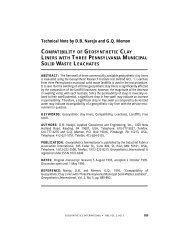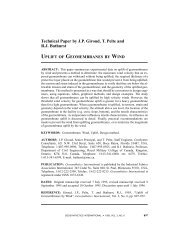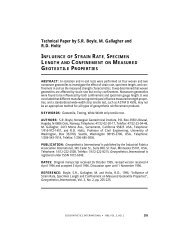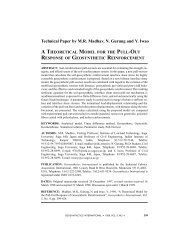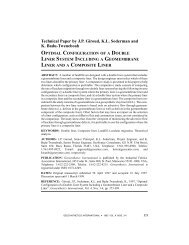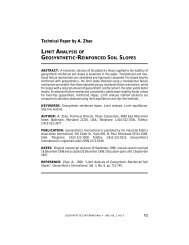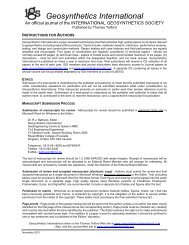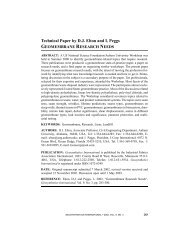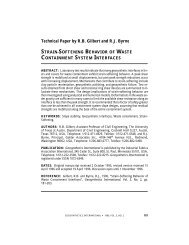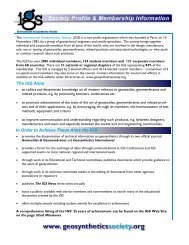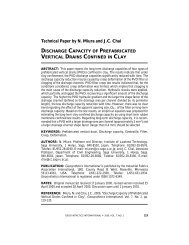leachate flow in leakage collection layers due to defects in ...
leachate flow in leakage collection layers due to defects in ...
leachate flow in leakage collection layers due to defects in ...
You also want an ePaper? Increase the reach of your titles
YUMPU automatically turns print PDFs into web optimized ePapers that Google loves.
GIROUD et al. D Leachate Flow <strong>in</strong> Leakage Collection Layers Due <strong>to</strong> Geomembrane Defects<br />
S If μ ≥ 2(whereμ is def<strong>in</strong>ed by Equation 111)<br />
L<br />
MF<br />
NHG<br />
32 /<br />
2 F ( Q/ k)<br />
2 L s<strong>in</strong>b<br />
2 L s<strong>in</strong>b<br />
Rwrand = 1 +<br />
+ 1 -<br />
3<br />
15 L s<strong>in</strong> b M Q/<br />
kKJ Q/<br />
k<br />
I<br />
52 /<br />
F<br />
HG<br />
I<br />
KJ -<br />
2<br />
O<br />
QP<br />
(130)<br />
Comb<strong>in</strong><strong>in</strong>g Equation 17 with Equations 121 and 126, respectively, gives the follow<strong>in</strong>g<br />
values of R w rand for the case where the <strong>leakage</strong> <strong>collection</strong> layer is full (t o > t LCL ), i.e.<br />
the case where the condition expressed by Equation 11 (or Equation 12, which is equivalent)<br />
is not met:<br />
S If μ ≤ 2(whereμ is def<strong>in</strong>ed by Equation 112)<br />
R<br />
w rand<br />
L<br />
F<br />
IO<br />
R<br />
L<br />
S|<br />
M<br />
N<br />
M<br />
T|<br />
3<br />
F tLCL<br />
Q<br />
= +<br />
L N<br />
M 1<br />
HG<br />
ktLCLKJ<br />
Q<br />
P 1+<br />
2<br />
60 s<strong>in</strong>b<br />
| M<br />
t<br />
S If μ ≥ 2(whereμ is def<strong>in</strong>ed by Equation 112)<br />
R<br />
w rand<br />
L<br />
F<br />
IO<br />
R<br />
L<br />
S|<br />
M<br />
N<br />
M<br />
T|<br />
3<br />
F tLCL<br />
Q<br />
= +<br />
L N<br />
M 1<br />
HG<br />
ktLCLKJ<br />
Q<br />
P 1+<br />
2<br />
60 s<strong>in</strong>b<br />
| M<br />
t<br />
LCL<br />
4 L s<strong>in</strong>b<br />
F<br />
HG<br />
Q<br />
1 +<br />
2<br />
kt<br />
LCL<br />
LCL<br />
O<br />
I<br />
KJ<br />
Q<br />
P<br />
4 L s<strong>in</strong>b<br />
F Q<br />
1 +<br />
2<br />
kt<br />
HG<br />
L<br />
N<br />
M<br />
+ 1 -<br />
t<br />
LCL<br />
LCL<br />
O<br />
I<br />
KJ<br />
Q<br />
P<br />
52 /<br />
4 L s<strong>in</strong>b<br />
F<br />
HG<br />
Q<br />
1 +<br />
2<br />
kt<br />
- 2<br />
LCL<br />
U<br />
V|<br />
W|<br />
O<br />
I<br />
KJ<br />
Q<br />
P<br />
52 / 52 /<br />
(131)<br />
- 2<br />
U<br />
V|<br />
W|<br />
(132)<br />
4.4.5 Critical Values of the Wetted Fraction <strong>in</strong> the Worst Scenario and the Random<br />
Scenario<br />
In Section 4.4, so far, it has been assumed that the wetted zones related <strong>to</strong> the various<br />
geomembrane <strong>defects</strong> do not overlap. The critical value of R w worst ,Crit(R w worst ), is the<br />
maximum value that R w worst can have without overlapp<strong>in</strong>g of the wetted zones related<br />
<strong>to</strong> the various <strong>in</strong>dividual primary l<strong>in</strong>er <strong>defects</strong>. This occurs when the parabolic wetted<br />
zones shown <strong>in</strong> Figure 9a are <strong>in</strong> contact at the low end of the <strong>leachate</strong> <strong>collection</strong> layer<br />
slope (Figure 11). This situation occurs when:<br />
W = max<br />
B / N<br />
Comb<strong>in</strong><strong>in</strong>g Equations 98, 100 and 133 gives:<br />
F =<br />
1<br />
LW max<br />
(133)<br />
(134)<br />
250 GEOSYNTHETICS INTERNATIONAL S 1997, VOL. 4, NOS. 3-4



